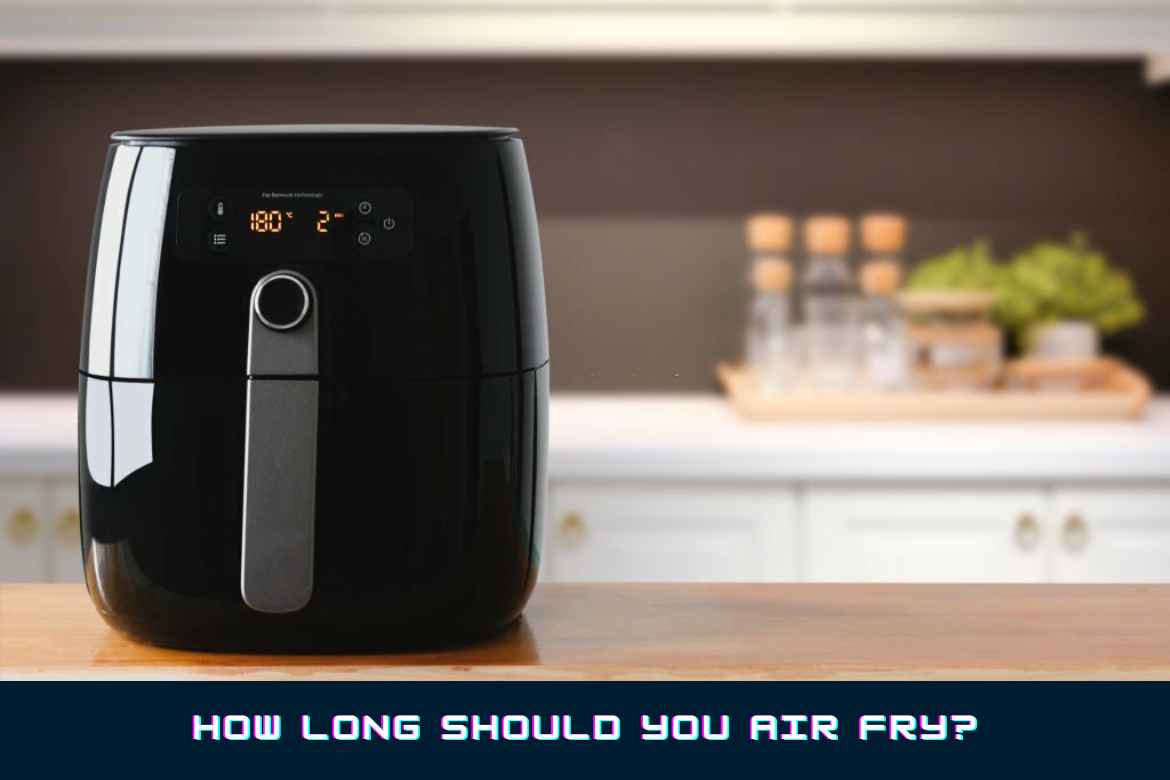Air frying has definitely taken the culinary world by storm in 2023, and it’s not hard to see why. It’s the difference between a mouthwatering, perfectly cooked meal and a culinary misadventure. So, if you’ve ever ended up with undercooked chicken or overly crispy fries, you’re not alone.
This raises the important question: “How long should you air fry?” In fact, it prides itself on achieving cooking times that are as much as 75% quicker than those of conventional convection ovens, guaranteeing that your dishes are prepared in a fraction of the time at some point. In this comprehensive guide, we will demystify the art of air frying while providing you with the knowledge and confidence to cook a wide range of dishes to perfection within the expected timeframes too.
Table of Contents
ToggleTemperature Settings and Their Impact on Cooking Time
1. The Role of Food's Thickness and Size
2. How Food Preparation Affects Cooking Times
Guidelines for Common Foods and Average Cooking Times
1. Vegetables
Air-frying vegetables is a breeze, and it’s a fantastic way to retain their natural flavours and textures while achieving that desirable crispy edge. Here are some approximate cooking times for commonly air-fried vegetables:
When preparing broccoli and cauliflower, you can expect them to be ready in around 12–15 minutes at 375°F (190°C), tossing them halfway through. Asparagus typically takes 8–10 minutes at 375°F (190°C). Zucchini and eggplant will be perfectly done in about 10–12 minutes at 380°F (193°C), with the need to flip them as needed. For Brussels sprouts, allocate 12–15 minutes at 375°F (190°C), shaking or stirring them occasionally. It’s worth noting that precise cooking times may vary based on your specific air fryer model, so it’s a good idea to keep a watchful eye on your veggies the first few times you prepare them.
2. Chicken
3. Fish
Air-frying fish can yield flaky, tender results with a crispy exterior. Here’s a handy reference for air-frying various types of fish:
Salmon is typically done in approximately 12–15 minutes at 380°F (193°C). Tilapia takes about 10–12 minutes at 370°F (188°C). Shrimp can be ready in 8–10 minutes at 360°F (182°C). It’s important to keep an eye on your fish and remember that thinner fillets will cook faster than thicker cuts.
4. French Fries and Other Frozen Snacks
5. Baked Goods (e.g., Muffins, Cookies)
For muffins, plan for 10–12 minutes at 320°F (160°C). Cookies usually take about 8–10 minutes at 350°F (177°C). When baking, remember that preheating your air fryer is essential to ensure even cooking, and different recipes may require slight adjustments in time and temperature to suit your preferences.
These guidelines should serve as a starting point for your air-frying adventures. Feel free to adjust times and temperatures based on your specific air fryer and personal taste preferences. The versatility of this kitchen tool allows for endless experimentation, so don’t hesitate to get creative with your air fryer recipes.
Testing for Doneness
1. Visual and Tactile Cues
One of the first things you can do to gauge doneness is to use your eyes and hands. For foods like vegetables, chicken, fish, and meats, keep an eye out for that beautiful golden-brown crispiness that air frying is known for. The exterior should be nicely browned and crisp, which is often an excellent visual indicator of readiness.
Tactile cues are equally valuable. Gently press or poke the food with a fork or your finger. It should feel firm and slightly crispy on the outside for dishes like chicken and fish. Vegetables should be tender, and meats should offer a little resistance but not feel hard. As you gain experience, you’ll develop a good sense of when your food is just right based on touch.
2. The Importance of Using a Food Thermometer for Precision
While visual and tactile cues are helpful, there’s no substitute for the precision of a food thermometer. It’s an invaluable tool for ensuring that your dishes are not only delicious but also safe to eat.
When cooking meats, especially chicken and poultry, it’s crucial to reach the recommended internal temperature to avoid any health risks too. The USDA suggests that chicken should be cooked to an internal temperature of 165°F (74°C), while for most cuts of beef, pork, and fish, the ideal temperature is lower.
To use a food thermometer, simply insert it into the thickest part of the meat, ensuring it’s not touching bone or fat. Wait for a few seconds until the temperature stabilises too. This will give you an accurate reading of the internal temperature, allowing you to make sure your dish is perfectly cooked and safe to enjoy.
Incorporating visual and tactile cues, along with a food thermometer, into your air-frying routine will help you become a true maestro in the kitchen. You’ll achieve consistent results, from crispy golden exteriors to perfectly cooked interiors, every time you use your air fryer. Plus, knowing your food is cooked to the right temperature ensures both your palate and your well-being are well taken care of.
Adapting Air Fryer Cooking Times for Special Diets
One of the fantastic benefits of air frying is its adaptability to accommodate various dietary preferences and restrictions. With a few adjustments to your air fryer cooking times, you can create mouthwatering dishes suitable for a range of special diets. Here’s how you can make it work:
- Low-Sodium Diets: For those following a low-sodium diet, you can still enjoy flavorful air-fried meals. Instead of relying on salt, explore a world of herbs and spices to season your dishes. By reducing or omitting salt, you’ll likely find that the natural flavours of the ingredients shine through. Adjust your cooking times according to your recipe while keeping an eye on doneness.
- Gluten-Free Diets: Individuals with gluten sensitivities or celiac disease can relish crispy delights using gluten-free breadcrumbs or coatings. Air-frying is a great way to ensure a gluten-free crunch without the need for excessive oils. Cooking times generally remain the same; just be vigilant in checking for that perfect texture.
- Vegetarian and Vegan Diets: Air fryers are a boon for vegetarians and vegans. You can create crispy veggie dishes and meatless alternatives with ease. Cooking times for vegetables and plant-based proteins typically align with standard recommendations, ensuring your dishes are cooked to perfection.
- Keto and Low-Carb Diets: For those embracing a low-carb or keto lifestyle, air-frying is ideal for achieving a crispy, carb-conscious crunch. Consider almond flour or coconut flour as coatings for your air-fried creations. Cooking times might need minor adjustments, but it’s a small price to pay for a carb-friendly indulgence.
- Allergen-Free Cooking: If you or your loved ones have food allergies, the controlled environment of an air fryer can provide peace of mind. Simply substitute allergen-free ingredients while keeping cooking times consistent. This allows you to savour the deliciousness without worrying about allergic reactions.
Remember to consult dietary-specific resources and recipes to tailor your air-frying to your particular needs. With a few tweaks to your ingredients and a keen eye on doneness, you can craft delectable air-fried dishes that cater to your dietary requirements, all while relishing the speed and flavour that air fryers bring to the table.

